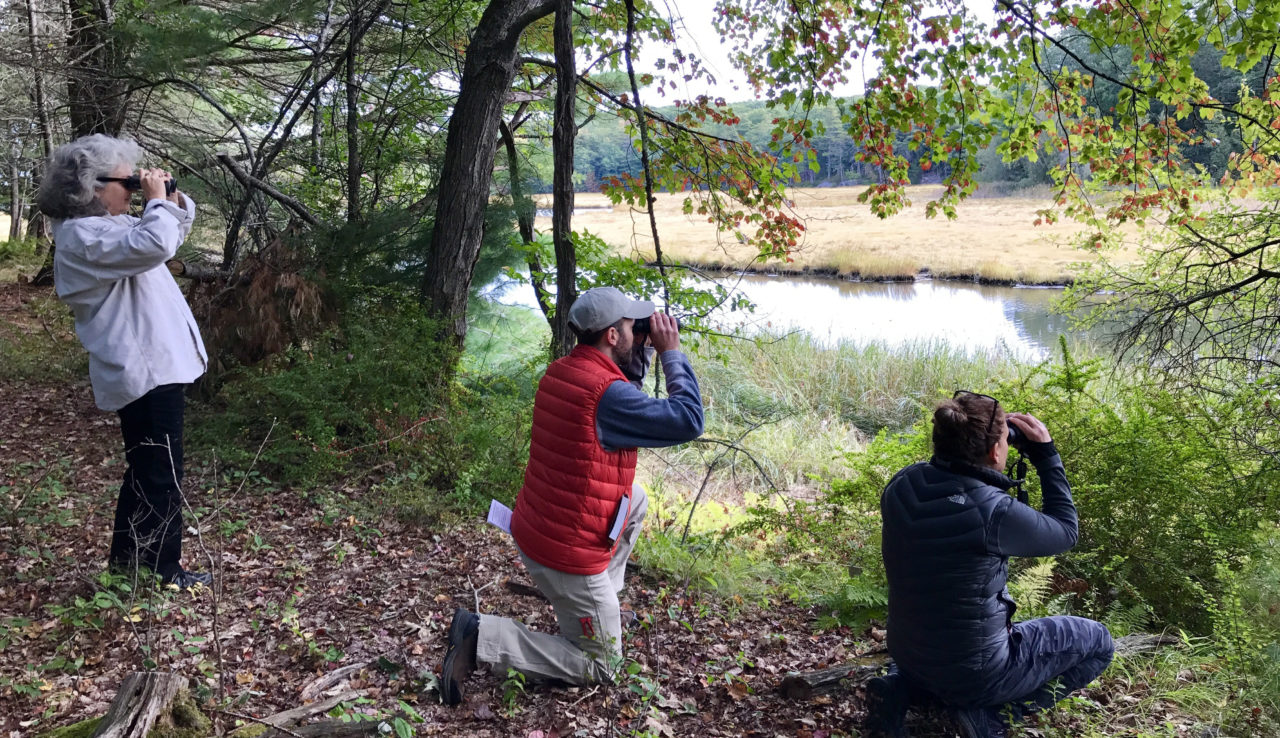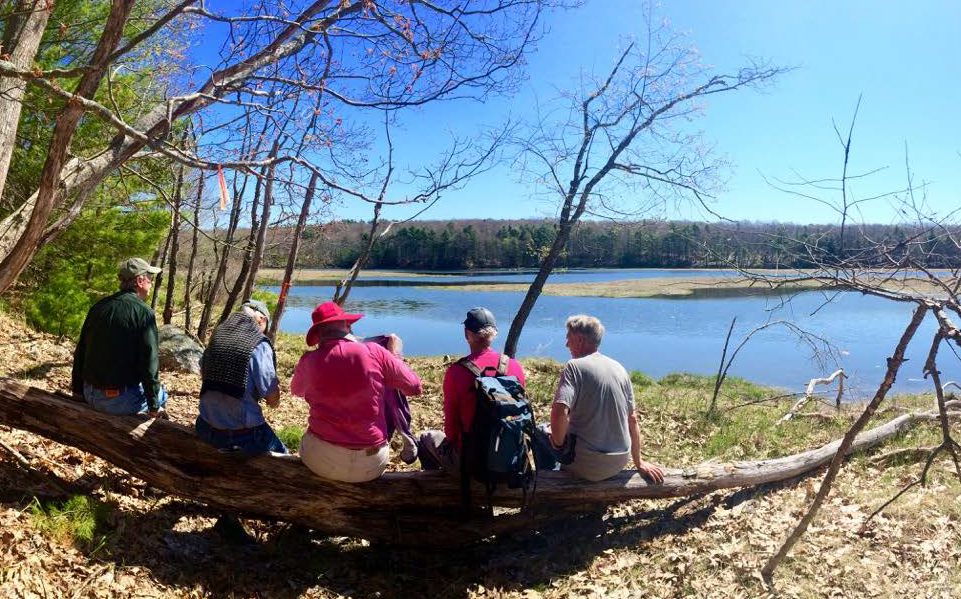Kennebec Estuary Land Trust
Why Bird Conservation?
The Kennebec Estuary Land Trust (KELT)’s preserves provide valuable opportunities for cultivating a sense of stewardship and awe amongst visitors to the Kennebec Estuary Region. The Kennebec Estuary comprises more than 20 percent of Maine’s tidal marshes, crucial habitat for many waterfowl species. However, increasing numbers of tourists and development projects threaten the estuaries of Maine, and the birds that depend on these ecosystems. KELT, located in Southern Maine, protects over 3,000 acres of land, including many of these at-risk coastal habitats, through conservation easements and property owned by the organization.
KELT also engages volunteers with citizen science projects — such as bird monitoring — which provide data for land acquisition and management decisions. Anna Christie-Carcinella, KELT Land Protection and Bird Conservation Coordinator, says KELT’s volunteer opportunities engage birders of all levels while collecting vital data for science and conservation. “These are popular volunteer opportunities that provide participants with the chance to directly interact with the natural world while also providing important scientific data,” she explains. “We saw an opportunity to expand our citizen science program with the addition of volunteer bird monitoring.”
The information gathered through this bird monitoring informs and strengthens other facets of KELT’s goals, such as advocating for the preservation of the estuaries and tidal marshes that serve as important habitat for nesting birds, resident birds, and migrating birds. Christie-Carcinella says that birds are essential to communicating the significance of the land and water protected by KELT.
“This project is so important because the Kennebec Estuary is such a rich place to bird diversity, and we are constantly losing shoreline, forests, and field habitats to development,” she said. “Being able to document the birds that are present and characterize this region really helps us prioritize conservation and make a strong case for keeping land undeveloped.”
Spotlight Resource: Outreach and Citizen Science

Recognizing the growing interest in bird watching, KELT used eBird, a free online bird checklist program, to expand its existing citizen science efforts. This expansion included the creation of an ‘adopt a preserve’ program and bird monitoring events. The ‘adopt a preserve’ initiative allows volunteers to sign-up to monitor birds at a specific KELT preserve throughout the year and participate in specific conservation projects. This not only builds the capacity of KELT through long-term volunteer engagement, but also encourages citizen scientists to form connections with the land. In addition, the consistency of bird monitoring at adopted preserves provides KELT with a robust source of data to inform habitat management efforts and land protection projects.
KELT’s bird monitoring program brought experienced birders to its preserves, while at the same time introduced many community members to birding for the first time. For many novice birders, eBird’s easy-to-use interface is an essential tool for building confidence when participating in these types of citizen science programs. KELT engaged all levels of birders through a variety of bird monitoring events.
One such event that brought KELT, citizen science volunteers, and other conservation organizations together for bird monitoring activities was the annual Birding Extravaganza. For this four-day event in 2019, KELT partnered with Merrymeeting Audubon, Harpswell Heritage Land Trust, and Brunswick-Topsham Land Trust to offer a variety of bird walks, led by experienced birders, at different properties. This included a bird walk at KELT’s new Red Rose Preserve, a property with hayfields home to nesting Boblinks, a species of bird that has suffered steep population declines from a loss of grassland habitat and farmland practices not compatible with the bird’s nesting season. The subsequent bird sightings at these events were recorded in eBird, thus the event not only served as a community engagement opportunity, but also added to the organization’s knowledge of bird species occurrence on its preserves. When land trusts like KELT contribute to eBird’s vast database, it fills data gaps on private lands making it possible for researchers to study bird populations at both local and landscape scales.
KELT has also been able to weave the new bird monitoring volunteer program into existing events for other taxa, further increasing its outreach to audiences who may not be familiar with birding. In April 2018, KELT hosted a bird walk on World Fish Migration Day, an event during which the organization usually holds an annual count of alewife, a fish native to the area. The inclusion of bird monitoring allowed volunteers already interested in citizen science to become familiar with eBird and learn how easy it is to use this accessible tool.
Making the Connection
By engaging with volunteer citizen scientists and expanding the use of eBird through its bird monitoring program, KELT has gained new information about birds that is valuable for informing habitat management, acquisition prioritization, and community engagement. One prominent management activity on KELT’s preserves is the creation and maintenance of trails for visitors. KELT has used data from eBird and volunteer observations to construct trails that optimize the protection of sensitive bird species and their habitats, offering ideal routes for birders.
Information gained from bird monitoring will also inform future management decisions for KELT preserves. For example, through a partnership with Maine Audubon’s Forestry for Maine Birds program, KELT is using bird monitoring to determine how different post-timber harvest prescriptions will impact bird species. The survey points for this program are eBird hotspots, and the collection of eBird data by citizen scientists will inform future forest management practices for improving bird conservation and overall forest health on KELT properties.
Advice to Other Land Trusts

Through the use of bird monitoring citizen science programs, KELT has found that bird conservation can build capacity and is integral to community outreach, management planning, and land acquisition.
Christie-Carcinella says that KELT now views bird conservation as critical to many of the organization’s activities beyond just the bird monitoring program. “Incorporating bird conservation into the organization in a multifaceted way has also meant that it is not only considered by a single project coordinator, but rather the entire staff is thinking about it in conjunction with an array of other considerations.”
Additionally, KELT’s collaboration with other organizations was essential in implementing its bird monitoring program. Partnerships with Maine Audubon and Merrymeeting Audubon gave KELT the opportunity to participate in birding events that expanded its outreach. Christie-Carcinella says that learning about the bird conservation resources offered by Cornell, including All About Birds and eBird, empowered her to work with and educate others on bird monitoring citizen science. Bird monitoring also provides land trusts with a baseline of information for adapting future management and conservation activities in the face of climate change. By better understanding bird species’ trends and behavior through this monitoring, land trusts learn which habitats are most crucial for protection as new threats emerge.
Next Steps
For KELT, engaging with birds and the birding community was only the beginning. Moving forward, their monitoring database will continue to inform management decisions across existing properties, be a core tenet of KELT’s programming and goals, and grow as a proactive component of land acquisitions. Rather than only assessing bird species information post-acquisition, KELT is working toward using data from eBird earlier in the land acquisition process. KELT has already developed a reputation as an organization with significant bird conservation expertise. “Having name recognition as a conservation organization involved in bird conservation has been really cool,” Christie-Carcinella says. “Seeing the response around the office and how it’s infiltrated the people here, people coming up to me and saying, ‘We’re thinking about this with the trail, what does this mean for birds?’ has been great.” By building a strong network of volunteer bird monitors, KELT has been able to extend its work to include data-driven bird conservation for the benefit of many different species and ecosystems in its area.
Note: The Kennebec Estuary Land Trust was a recipient of a 2017 Land Trust Small Grant award.


